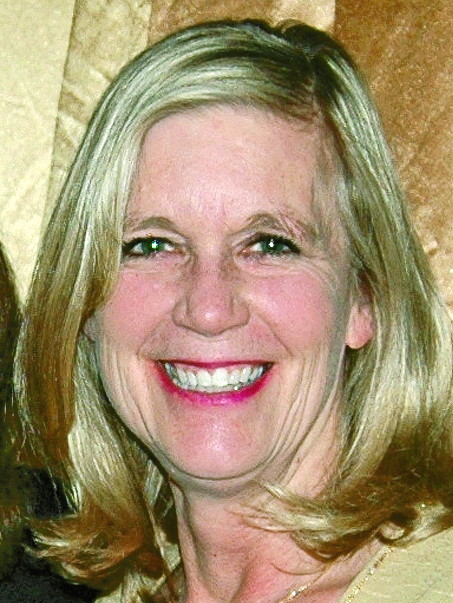
by Mark Smiley | Oct 21, 2016 | Travel
Publicity Shy Health And Wellness Director Will Be Missed By All, In Particular The SilverSneakers Seniors

 by Mark Smiley
by Mark Smiley
Ellyn Wood, the Glendale Sports Center’s Health and Wellness Director is retiring after 35 years with the YMCA. Having just turned 65 years of age, Wood is hanging up her sneakers on November 30, 2016. Wood, who shies away from the spotlight and prefers to not have a lot of publicity surrounding her, has devoted most of her adult life to the YMCA and its sports programs.
Wood started with the Chatfield YMCA in 1981 as a part-time fitness instructor after exercising there since 1979. She exercised with Debbie Ford, who served the YMCA in many capacities including Executive Director of the Glendale Sports Center. Ford, who has been friends with Wood since the 7th grade, retired from the YMCA three years ago.
As the two described it, they exercised wearing leotards, leg warmers and leading group exercise classes which was the style in the late ’70s and early ’80s.
“As an executive at the Littleton Y and then later at the Glendale Sports Center it was a privilege and fun to work with Ellyn,” said Debbie Ford, YMCA of Metropolitan Denver, past Glendale Sports Center/ YMCA Executive Director. “Ell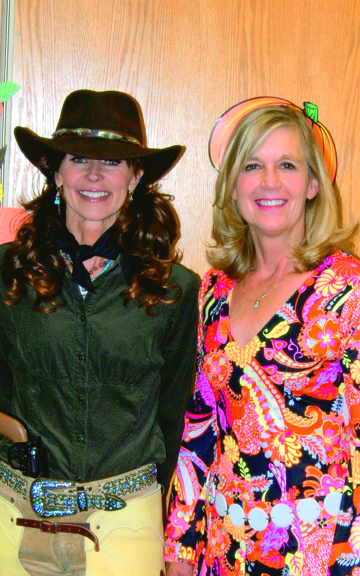 yn has brought a lot of happiness to members, especially the SilverSneakers. Ellyn has been a very committed, dependable, and innovative employee, you can always count on Ellyn.”
yn has brought a lot of happiness to members, especially the SilverSneakers. Ellyn has been a very committed, dependable, and innovative employee, you can always count on Ellyn.”
Wood moved to full-time status in 1991 after teaching aerobics at the YMCA as well as some private clubs around town. In 1991, she helped open up the Highline (now Littleton) YMCA and served as Fitness Coordinator. She also ran a large teen sports program and even supervised the pool.
After being promoted to Health and Wellness Director, she was laid off in 2002 only to return two weeks later when the branch reorganized.
Then, a call came from Debbie Ford. Ford tried to convince Wo od to join her at the newly formed Glendale YMCA. “I didn’t want to leave Littleton,” said Wood. “I felt comfortable there but Debbie wanted me to come [help open the Glendale location]. She talked me into it.”
od to join her at the newly formed Glendale YMCA. “I didn’t want to leave Littleton,” said Wood. “I felt comfortable there but Debbie wanted me to come [help open the Glendale location]. She talked me into it.”
From 2002 to 2008, Ford and Wood were two of the only full-time employees in the old building. Then, in July 2008, the City of Glendale opened a 35,000-square-foot recreation and sports center and asked the YMCA to manage it. Wood was in on the ground floor of every aspect of the new facility from scheduling and hiring to recruiting new members and running the SilverSneakers program.
And that is what Wood will miss the most. “…the people. I’ve known a l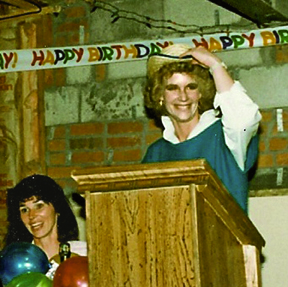 ot of them [seniors] since we were over in the old building,” said Wood. “They are always reminiscing about times in the old building. Because it was just me, I paid a lot of attention to them. They were almost like a family. They loved it.”
ot of them [seniors] since we were over in the old building,” said Wood. “They are always reminiscing about times in the old building. Because it was just me, I paid a lot of attention to them. They were almost like a family. They loved it.”
Times have changed since leaving the old facility in 2008. Over the last eight years, membership has grown exponentially. “It has been nice to see how the membership has grown and how the classes have grown [since moving into Infinity Park] from when we first started over here,” said Wood.
“From teaching classes, to making sure all the members have coffee and repairing equipment Ellyn has done it all,” said Nicole Limoges, Executive Director, YMCA Sports Branch & Glendale Sports Center at Infinity Park. “She is the most energetic, caring staff person I have had the pleasure to work with and she will be g reatly missed by the members and staff.”
reatly missed by the members and staff.”
Now, it is time to turn a new page in Wood’s life. She and her husband Woody plan to travel. They will visit Baja Peninsula in Mexico, over Thanksgiving and have plans to visit Africa, Greece, Croatia, New Zealand, and Australia.
No trip may be as exciting as visiting their daughter Courtney and two grandkids in California or their son Shane and his wife Stephanie in Italy.
Aside from travel and helping her husband at home with bookkeeping for his business, Wood hopes to enjoy the time off and will be looking to fill her days and be productive. After working for 35 years for one organization, Wood has earned the right to enjoy life on her own terms.

by Mark Smiley | Oct 3, 2016 | Travel
Valley Brewing Horrifying, Hilarious Month Filled With Terror-ific Goolish Fun

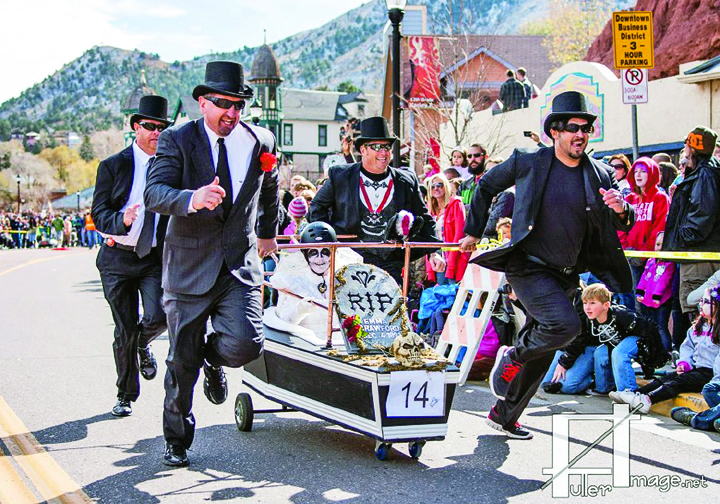
 Straddling the line between fall and winter, plenty and paucity, life and death, Halloween is a time of celebration and superstition. It has become a quintessential month of celebrations in the Cherry Creek Valley. It is a month when people project their fears in a safe and playful way. When else will you see images of death on suburban lawns? It is thought to have originated with the ancient Celtic festival of Samhain, when people would light bonfires and wear costumes to ward off roaming ghosts.
Straddling the line between fall and winter, plenty and paucity, life and death, Halloween is a time of celebration and superstition. It has become a quintessential month of celebrations in the Cherry Creek Valley. It is a month when people project their fears in a safe and playful way. When else will you see images of death on suburban lawns? It is thought to have originated with the ancient Celtic festival of Samhain, when people would light bonfires and wear costumes to ward off roaming ghosts.
In the eighth century, Pope Gregory III designated Nov. 1 as a time to honor all saints and martyrs; the holiday, All Saints’ Day, incorporated some of the traditions of Samhain. The evening before was known as All Hallows’ Eve and later  Halloween. Over time, Halloween evolved into a secular, community-based event characterized by child-friendly activities.
Halloween. Over time, Halloween evolved into a secular, community-based event characterized by child-friendly activities.
Here’s the Chronicle’s monster month list of bewitching places to go and things to do to have a fang-tastic time to keep “spirits” bright:
Brewing Adult Fun
Coloween
Curtis Hotel, Oct. 29, 9 p.m. -2 a.m.
Coloween is one of the Valley’s best nightmares. Revered as one of the top Halloween costume parties in the state, the 9th annual event summons Denver’s seasoned partygoers as downtown’s Curtis Hotel is transformed into a frightfully fantastic open bar hotel takeover experience! Party if you dare, through two levels of haunted hallways and hair-raising entertainment as you make your way into three ballrooms featuring DJs, live musical acts, festival-quality sound and lighting production, sexy theatrical performers and 28 bartenders. Information: 303-571-0300.
Denver Halloween Costume Ball
Mile High Station, Oct. 29, 9 p.m.-2 a.m.
You won’t find a spookier place to attend a costume party than the century old Mile High Station. Located in the heart of downtown, the venue includes an elevated mezzanine, oversized patio and complimentary parking. The open bar ball offers an all you can drink party package with a premier open bar all night, a $1,000 “Best of The Ball” Halloween costume contest, live Halloween entertainment and DJs. In formation: 720-946-7721.
formation: 720-946-7721.
Halloween Boo-Lesque Show
Lannie’s Clocktower Cabaret, Oct. 28-29
Join the adorable Clocktower Clockettes at Lannie’s Clocktower Cabaret as they pay a spooky burlesque tribute to all the thrills and chills of America’s spookiest holiday! You’ll see zombies, vampires, witches, black cats and even The Blob… s cenes so frightening they’ll scare The Clockettes right out of their shirts. The event features aerial feats, jugglers, magicians, comedy and camp by Lannie’s very own host Naughty Pierre. It’s old-fashioned fun with interactive comedy and costume-contest prizes. Two shows nightly, 8 p.m. and 11 p.m. Information: 303-293-0075.
cenes so frightening they’ll scare The Clockettes right out of their shirts. The event features aerial feats, jugglers, magicians, comedy and camp by Lannie’s very own host Naughty Pierre. It’s old-fashioned fun with interactive comedy and costume-contest prizes. Two shows nightly, 8 p.m. and 11 p.m. Information: 303-293-0075.
Victorian Horrors
Molly Brown House Museum
Oct. 14-15, 21-22 & 28-29, 6-9 p.m.
“I became insane, with long intervals of horrible sanity.” Enter Poe’s nightmarish world as featured at the Museum’s 23rd event every 15 minutes from 6-9 p.m. Take a literary journey of fright with such authors as Poe, Wells and Lovecraft, hearing tales of unspeakable horror and madness. Event is suitable for ages 12 and up with parental discretion. Information: 303-832-4092.
Pumpkin Hunts & Haunts
Pumpkin Harvest Festival
Four Mile Historic Park
Oct. 1-2, 10 a.m.-4 p.m.
Build your own scarecrow, select the perfect pumpkin from the patch, dance to live music, play pioneer games, and more. Historic demonstrations and tours of the Four Mile House Museum will highlight how families lived and prepared for the season during the late 1800s. Horse-drawn wagon rides will be offered each day. Stay refreshed with delicious offerings from local vendors and food trucks. Admission is free but additional charges apply for refreshments and some activities. A beer garden (21 and up) will be on site courtesy of Copper Kettle Brewing Company. Information: 720-865-0800.
Glow At The Gardens
Denver Botanic Gardens,
Oct. 19-20 & 26-27. 6-9:30 p.m.
The Gardens light up the night with hundreds of carved, glowing jack-o’-lanterns. Luminaria-lined pathways wind through the Denver Botanic Gardens to reveal-larger-than-life pumpkin displays. In addition, enjoy indoor activities including live music, costume contests and hands-on crafts. Seasonal food and beverages are available for purchase. Each week features a different theme: Fables & Fairy Tales Oct. 19-20 and Spooky Hollow, Oct. 26-27. Information: 720-865-3501.
Goblins On The Run
Scream Scram
Wash Park, Oct. 21, 6:30 p.m.
A Halloween-themed 5K treat-filled run-walk in Wash Park to raise funds for the Boys & Girls Club. Bring the family (and the dog!) and put together your best costume for this Halloween-themed event that begins with a costume contest at 5 p.m. a nd a kids spooky sneak at 6:15 p.m. Consider forming a team with your colleagues for a fun filled Friday night. Race t-shirts and a treat-filled post-race expo will leave you or your company feeling great about helping low-income youth live healthier lives. Information: 303-892-9200.
nd a kids spooky sneak at 6:15 p.m. Consider forming a team with your colleagues for a fun filled Friday night. Race t-shirts and a treat-filled post-race expo will leave you or your company feeling great about helping low-income youth live healthier lives. Information: 303-892-9200.
Terror-ific Theater
The Crucible
John Hand Theater, Weekends Oct. 8-Nov. 5
The Crucible playing at the John Hand Theater in Lowry is a Halloween masterpiece. Written as a parable of the McCarthy “witch hunts” launched against supposed communists in the 1950s, Arthur Miller’s timeless drama about the Salem witch trials is a powerful statement about the American tendency toward mass hysteria. Set in 1692 Massachusetts, The Crucible explores the frightening paranoia that takes hold when five young girls claim to have been visited in the night by the devil. A chilling psychological stage play about the disturbing effects of mob mentality during intellectually unstable and confronting times. Information: 303-562-3232.
Night Of The Living Dead
The Bug Theatre, Oct. 7-29, 8 p.m.
The Bug Theatre and Paper Cat Films are back to bring the biggest and best Halloween treat to the Bug stage. Back for an eighth bloody year, it plays Friday and Saturday evenings. Theme for this year’s show is Urban Legends. Expect the classic story of seven people trapped in a farmhouse, surrounded by flesh-eating ghouls. One has the virus, one has a gun and one has lost her mind. Plus, there’s a lunatic hook man, spiders in a beehive and calls coming from inside the house. A unique aspect of the show is that the entire action-taking place inside the famous farmhouse is on stage, while all the action outside the house is projected onto an overhead screen, utilizing sequences re-created and shot by Paper Cat Films. Information: 303-477-9984.
Frankenstein
Stage Theatre, DCPA through Nov. 12
Given life from a man with a troubled heart, a creature assembled from corpses sets out into the unforgiving world to discover his humanity. As he uncovers both kindness and cruelty, he seeks out the doctor who created him to demand answers about his troubled existence. Frankenstein features two lead actors alternating performances in the roles of Victor Frankenstein and his creature, allowing man and monster to intersect with every chilling performance of this U.S. premiere. Information: 303-892-4100.
Creepy Tours
Capitol Hill Haunts
Friday & Sat., Oct. 1-31
Expect encounters with angry apparitions, spirit wanderings and grisly accidents at one of Denver’s most haunted locations, Cheesman Park! Tour departs from the southeast corner of N. Gilpin St. and W. 13th Ave. on the north side of Cheesman Park at 7 p.m. on Fridays and 8 p.m. on Saturdays. You may be a skeptic when you start but goulish guides will have you convinced by the end of your walk that Denver is full of spirits from times long ago. The two-hour tour is suitable for ghouls and humans ages 12 and up. Information: 720-372-3849.
Escape Denver
Pumpkin Festival Trains
Georgetown, Oct. 1, 2, 8, & 9
Georgetown Loop Railroad’s ever-popular event is back with a new location for your enjoyment on the first two weekends of October. The festival is set up at the Silver Plume car museum, with a “Bouncie” castle, pumpkins for kids to decorate and take home, games, face painting plus wonderful characters to entertain the little ones. Information: 888-456-6777.
Emma Crawford Coffin Races
Manitou Springs, Oct. 29, 12-4 p.m.
Each year more than 10,000 people travel to Manitou Springs for the fun and festive Coffin Races. Teams of five — one Emma and four runners — push their coffins 195 yards to the finish line. There are trophies for Fastest Time, Best Emma, Best Entourage and Best Coffin. There’s also a separate fire department division. The races start off at noon with a parade of all the coffins and teams as well as authentic hearses. Information: 800-642-2567.
Kids & Family Treats
Trick or Treat Street
Children’s Museum of Denver,
Oct. 28-30, 9 a.m.-6 p.m.
The Children’s Museum of Denver at Marsico Campus is hosting a spooktacular wonderland of fun. Families can march from one Treat House to the next and collect goodies, create Halloween crafts, play carnival games and walk in festive parades. Bursting with excitement, it’s the ultimate safe and delicious Halloween adventure for youngsters and their family. Information: 303-433-7444.
Hauntings In The Hangar
Wings Over the Rockies, Oct. 29, 12-4 p.m.
Werewolves, witches and wandering spirits of all ages are invited to spend a spooky Saturday in the hangar at Lowry. Kids will get pleasure seeing Sci-Fi characters while enjoying space treats in the spooky hangar. They can tumble down an inflatable slide and work their way through an obstacle course. And, of course, kids can show off their Halloween costumes in the costume parade. Information: 303-360-5360.
Boo At the Zoo
Denver Zoo,
Oct. 22-23 & 29-30, 9 a.m.-5 p.m.
The animal park offers 20 trick-or-treat stations, creepy crawly animal demonstrations and exciting family-friendly entertainment under the canopy of the beautiful fall foliage of the Denver Zoo. For those who love Boo at the Zoo but prefer to trick-or-treat in the evening, Boo After Dark is offered the same days from 6:30-9 p.m. Information: 720-337-1400.
Halloween Event
Glendale Sports Center, Oct.31
Bring the kids to the Glendale YMCA Sports Center for an evening of spooky fun. Enter the costume contest, or travel through the haunted house if you dare. Information: 303-639-4711.
Jeepers Creepers Music
Covenhoven & King Cardinal
Eisenhower Chapel, Nov. 4, 8 p.m.
Covenhoven’s ethereal balladry evokes a not-too-distant past filled with ghosts and inspiration, and puts listeners on notice that songwriter Joel Van Horne’s voice is one to be reckoned with. King Cardinal’s soulful folk, meanwhile, can slip effortlessly from soft and contemplative to raucous and celebratory all in the snap of a snare drum. Information: 303-777-1003.
Halloween Spooktacular
Boettcher Concert Hall, Oct. 31, 2:30 p.m.
A family tradition of the not-too-scary sort, this Colorado Symphony concert features musical fun for the whole family. Music will include Harry Potter and the Sorcerer’s Stone Suite, the Star Wars Theme and the Superman March. Everyone is encouraged to dress up for the Halloween festivities, and the Colorado Symphony musicians will trade-in their tuxes and tails for their own zany costumes. Don’t forget to arrive early for the Halloween pre-concert activities in the lobby! Information: 303-623-7876.
Scary Haunted Houses
The Asylum
Oct.1-31, 7-11 p.m.
This haunted house at 6100 E. 39th Ave. is Denver’s top-rated haunted attraction. Back again for another year of thrills, this 1800s-era themed “hospital for the mentally insane” has been taken over by the patients and prisoners. Tapping into some of our greatest fears, the haunted experience is a head-trip, in which tortured souls scream inside the once orderly insane asylum. Information: 303-355-3327.
The 13th Floor
Oct. 1-Nov. 12, 7-11 p.m.
Hailed by Fangoria Magazine as “the #1 scariest haunted attraction in the U.S.,” the 13th Floor Haunted House at 4120 Brighton Blvd. takes guests through a frightening tour of horror. Brave souls will learn just why the 13th floor is so often omitted from building plans — if they make it through to tell the tale. This year promises new thrills with intricate sets, highly selective casting and incredible special effects makeup that is sure to make reality and fiction blur into terror. Information: 303-355-3327.
Halloween Extremes
Halloween contains trick or treats, haunted houses, witches, ghosts and superheroes designed to amuse children. What about grown-ups than never did grow up?
Instead of accompanying kids and grandchildren for begging on a dark and stormy night, some adult singles still get their own chance at Halloween their way. The exact date of Halloween is two days after the Saturday parties.
Most young parents and non-parents observe the event at bars and nightclubs that will be recognizing the theme. Then there are the private costume parties especially for adults of all ages.
The ultimate and extreme party in Denver is the 8th Annual Paranormal Palace on October 29, 2016. The outrageous party returns this year to the newly renovated McNichols Civic Center Building at 114 W. Colfax Ave. Adjacent to the City and County Building, the former Carnegie Library just re-opened after a $5.5 million remodel.
And the first big event for the historic structure is very scary in many ways.
The Paranormal Palace attracts more than 2,500 costumed guests who will enter through a 25-foot skull entry. Once inside there are 20-foot spiders, two bands, two DJs, and more than 30 performers and models. Music is billed as “Monster beats from Top 40 mash ups to hip-hop ’80s and terrifying grooves that pound the Palace walls.”
The sensory overload has a variety of prices starting at $95.37 including tax but only 958 tickets were available at time of press. The limited consumption tickets are cheaper but sold out. Special seating costs more all the way up to a “three-person couch pit” for $299 plus tax.
This is the eighth year that Kevin Larson has presented this event for the 21-50 age group. This year it is also a fundraiser for the V-2 Education Foundation. More information is available on his very strange website ParanormalPalace.org.
At the other end of the dancing and drinking spectrum is the annual Boomer Social Halloween Dance. This age 50-plus group has already seen their share of Halloween, first through the eyes of their children and now their grandchildren. They also have a wealth of costume background. So, now it is their turn but in a more sedate style.
Far from an open bar, their first and often only drink is included in the $15 admission. Music is familiar, what they remember from different times of their life and is not loud.
Their favorite entertainers are the duo of Tony David and Kerry Edwards who sing recorded songs exactly the way they were written. Costumes are less blood and gore but often sexy and more imaginative. They are still dating so look your best in a costume you like emulating a celebrity they admired.
The crowd dances non-stop but leaves promptly at 11 p.m. on Saturday night so the semi-revelers can rest and be ready for church in the morning.
The adult singles celebration is usually in a sedate Southeast Aurora hotel, but this year it is at The Rendezvous Restaurant, adjacent to Heather Gardens Community Center. Doors open to party guests at 7:30 p.m., after the Early Bird Special is served and cleared. The music starts at 8 p.m. with line dancers filling the floor.
No reservations are required or taken. More information and photos are at www. Boomersocial.net. For more information about Paranormal Palace, visit www.para normal palace.org.
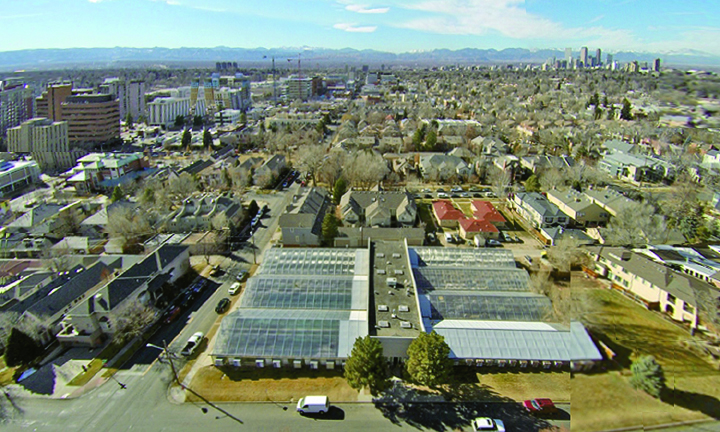
by Mark Smiley | Aug 29, 2016 | Travel
Neighborhood, City Council Okay Garfield Plans; Milwaukee Development Looms
 Given the shadows cast by an ever-increasing rash of skyscrapers from the nearby business district, residents in Cherry Creek North’s tony residential neighborhood north of 3rd Ave. become exceptionally nervous with regard to potential changes to its character. These are the residents, after all, that urged, “Smart development, not overdevelopment” for the Cherry Creek’s business district.
Given the shadows cast by an ever-increasing rash of skyscrapers from the nearby business district, residents in Cherry Creek North’s tony residential neighborhood north of 3rd Ave. become exceptionally nervous with regard to potential changes to its character. These are the residents, after all, that urged, “Smart development, not overdevelopment” for the Cherry Creek’s business district.
Thus when the two largest remaining parcels within the residential neighborhood — a rare corner with six contiguous lots at 2nd Ave. and Garfield, the other a five-lot plot between 320-260 Milwaukee, and both zoned G-RH-3 — became potential development sites residents quickly became skittish. The Cherry Creek North Neighborhood Association (CCNNA) and Councilman Wayne New reached an agreement for the Garfield development that was approved at the August 22 City Council meeting. Sale of the Milwaukee property just closed and information isn’t yet available on plans for development at that location.
When initially learning that the family that owned the Garfield property was planning to build garden court style apartments, neighbors objected declaring they would look like “army barracks.” They requested the city review the intent of the code and listen to their concerns. City Councilman Wayne New — a past president of the CCNNA — along with colleague Councilman Rafael Espinoza then asked for a one-year city-wide moratorium on the garden court concept so the zoning code could be corrected or clarified. Other council members, however, expressed concern that the yearlong moratorium could halt other city projects.
Silver Lining
There is a silver lining to the development cloud, at least for the Garfield property. Paula Newberry-Arnold and her son Kien whose family have owned the property for nearly 70 years finalized an agreement with the CCNNA led by president Bob Vogel that proved acceptable to both the neighborhood and the family. Under the agreement, the number of units in the development was decreased from 30 down to 26, with no stacked units. Moreover, the courtyard space between buildings was expanded to 33 feet versus the original 16 feet.
Furthermore there will actually be gardens within the development not just doors, notes Councilman New. He says his review of the plan gave him the assurance he needed to amend the moratorium. On August 22 the Denver City Council agreed, lifting the moratorium on current projects including Garfield, but approved the year-long halt for new projects city-wide..
The neighborhood is just beginning to learn about the five-lot plot located between 320-360 Milwaukee. It just sold for $7,600,000, unofficially a record price of $1,520,000 per lot. Neither the buyer nor plans for development of that property have yet been disclosed. However, up to 10 units — condos, flats or townhomes — could be built, potentially including the garden court designs.
Flowering Since WWII
Weldon Newberry and two of his brothers originally purchased a greenhouse at the Garfield location in Cherry Creek just after WWII and began growing famed Colorado Carnations, the first trademarked flower in the U.S. A few years later, Weldon and his wife Elizabeth purchased full ownership from the remaining brother. With fuel prices skyrocketing, carnations were being shipped into the states cheaper than they could be grown in the greenhouse. At this point, the greenhouses were used to grow a large variety of flowers and plants and Elizabeth Newberry focused on developi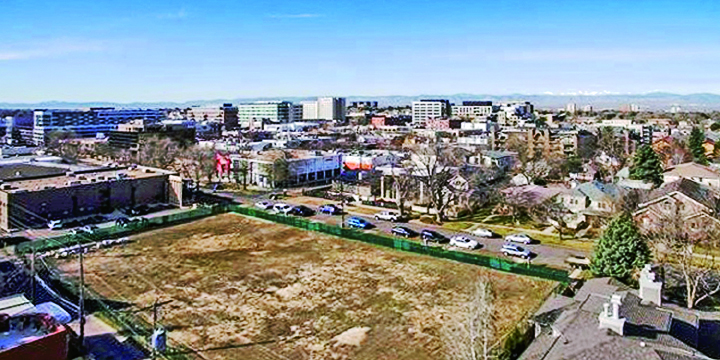 ng the wedding and floral side of the business.
ng the wedding and floral side of the business.
The daughter of Weldon and Elizabeth Newberry, Paula Newberry-Arnold now co-owns the business with her son Kien Arnold. The business has developed into one of Denver’s top floral and décor shops specializing in large themed events and custom floral design. Earlier this year they relocated the business into the former Natural Grocers property on Leetsdale Drive (Chronicle, January 2016).
Originally 500 Cherry Creek North neighborhood homeowners signed a petition protesting the proposed Garfield development. Now, however, many say they look forward to it being built believing it will be an improvement over the greenhouses that weren’t exactly an asset to the neighborhood.
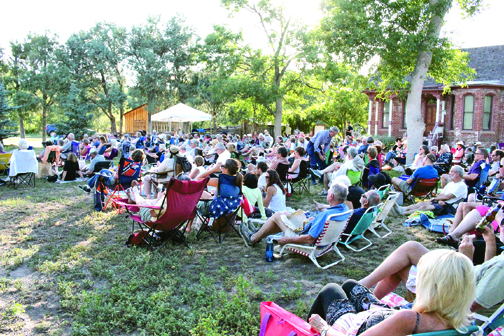
by Mark Smiley | Jul 22, 2016 | Travel
by Megan Carthel
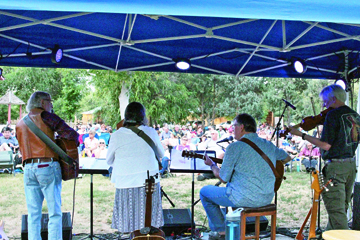 Happening every Wednesday night from June 8 to August 17, the Shady Grove Picnic Series is a delightful night of local and national music talent. A crowd gathers together with picnics, friends and family, fresh air and good music. The Four Mile Historic Park adds the perfect backdrop to this almost two-decade musical tradition. So far this year, the Shady Grove Picnic Series goers have had the pleasure of hearing the musical talents of Wendy Woo and Friends, Perpetual Motion and Sweet B and Her Moonshine.
Happening every Wednesday night from June 8 to August 17, the Shady Grove Picnic Series is a delightful night of local and national music talent. A crowd gathers together with picnics, friends and family, fresh air and good music. The Four Mile Historic Park adds the perfect backdrop to this almost two-decade musical tradition. So far this year, the Shady Grove Picnic Series goers have had the pleasure of hearing the musical talents of Wendy Woo and Friends, Perpetual Motion and Sweet B and Her Moonshine.
Harry Tuft and his friends played a magical set on July 13. The folksy-country sound was a perfect match for the evening’s warm breeze and shady trees. Marti Friednash, Mag Hayden, Ron Jones and Jack Stanesco joined Tuft on stage, adding not only a mix into the music, but bits of comedy. It was truly an enjoyable show for every age.
The Shady Grove Picnic Series is the perfect family night, date night or evening out of the house, and with the Em’s Ice Cream truck at every show doling out fresh and cold organic scoops of delicious home-made ice cream, it’s a great way to cool off and relax after a long, hot summer day.
These relaxing Wednesday evenings are put on by Swallow Hill Music, a non-profit organization for musicians and music lovers. Barry Osborne, mar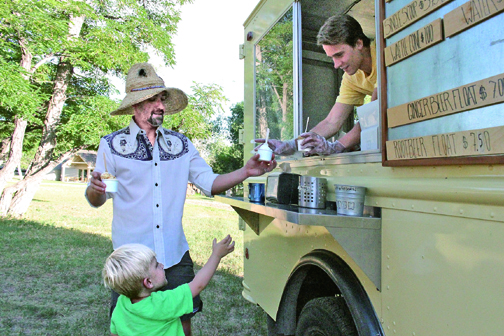 keting manager for Swallow Hill Music, said the Shady Grove Picnic Series is a more low-key concert that allows friends to come together, listen to music, chat, enjoy each other’s company. It’s safe to say music fans are transported to a summer oasis within the city limits. The family-friendly and laid back environment gives younger music fans the chance to experience live music. Swallow Hill Music works with Four Mile Historic Park to put together these summer staple Wednesday nights and to find emerging talent.
keting manager for Swallow Hill Music, said the Shady Grove Picnic Series is a more low-key concert that allows friends to come together, listen to music, chat, enjoy each other’s company. It’s safe to say music fans are transported to a summer oasis within the city limits. The family-friendly and laid back environment gives younger music fans the chance to experience live music. Swallow Hill Music works with Four Mile Historic Park to put together these summer staple Wednesday nights and to find emerging talent.
“The Shady Grove Picnic Series is a great way to introduce music fans to bands they might not be aware of,” Osborne said.
For the bands, it’s a chance to get in front of a larger crowd than they’re used to — with about 100 or so people gathering around the tent stage.
While the Shady Grove Picnic Series generally showcases folk music, other genres are making an appearance this year. Color, a funk, soul band driven around a guitar lending to a modern-soul sound, and The Scones, with an Americana-Ro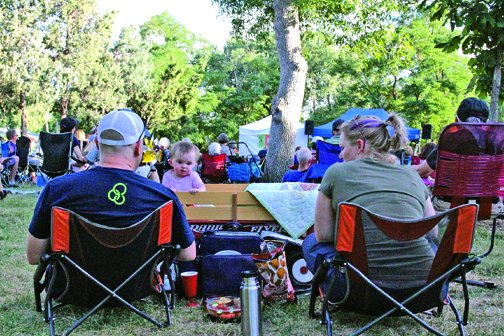 ck-and-Roll sound, are sure to shake up the Shady Grove scene with new and exciting sounds.
ck-and-Roll sound, are sure to shake up the Shady Grove scene with new and exciting sounds.
“Even though we’re known as a folk organization and present a lot of folk we feel the American music experience is broad enough we can push that,” Osborne said.
For Osborne, when everything from the audience to an energetic live band comes together, putting on these shows is amazing. “[The Shady Grove Picnic Series] feels like a hallmark of summer in Denver,” said Osborne.
Swallow Hill Music does more than put on concerts. The non-profit has a music school that employs experienced and talented musicians. Students learn a song by the end of their first class. But teaching isn’t all Swallow Hill Music does; the non-profit hosts “exceptional musical experiences” throughout the year in the Denver community. Their concerts feature up-and-coming artists, local talent and national talents who “enrich the local arts scene.”
This year, tickets are available online or at the door. An evening of great music and picnics is a steal at $12 for adults, $8 for Swallow Hill Music and Four Mile Historic Park members and kids under 12 can enjoy the music for only $2 — kids under two are free. For more information, visit Swallow Hill Music’s website swallowhillmusic.org.
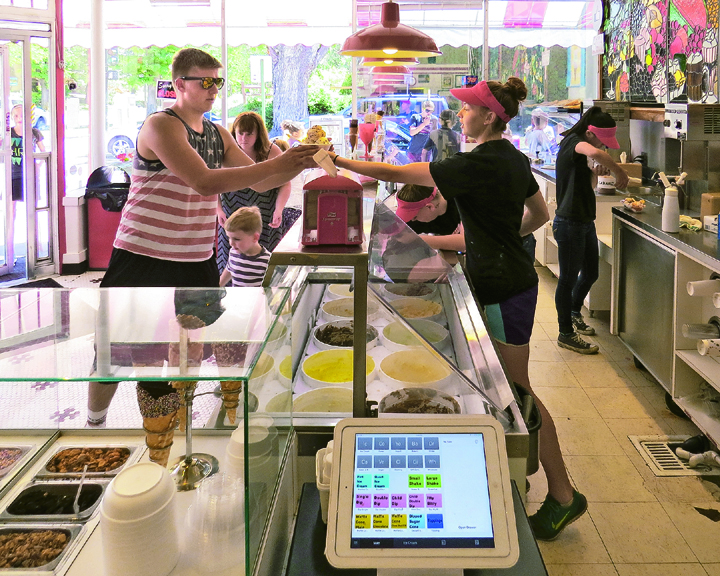
by Mark Smiley | Jun 24, 2016 | Travel
by Mark Smiley
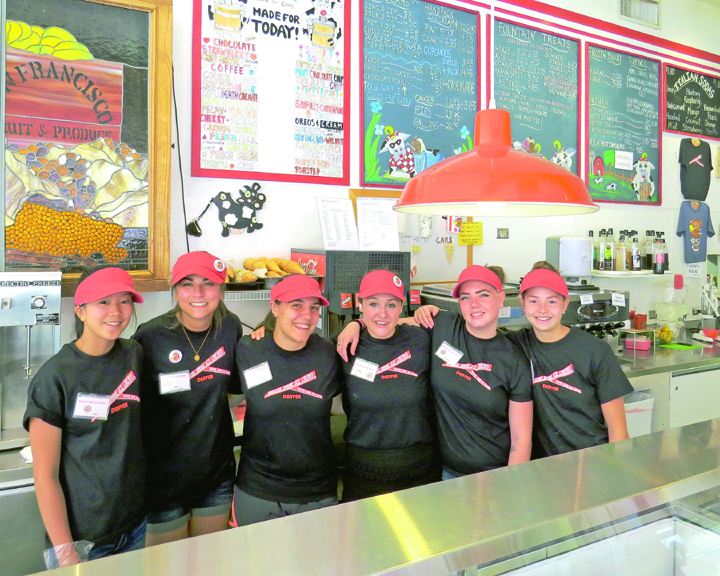 On July 23, Bonnie Brae Ice Cream will celebrate its 30th Anniversary under the same ownership and in the same building as when it first opened. Co-owner Ken Simon estimates they have scooped 8,250,000 scoops of ice cream in 30 years. Not to mention 35,000 ice cream cakes. Simon also indicates that Bonnie Brae Ice Cream is the oldest ice cream parlor under continuous ownership in Denver.
On July 23, Bonnie Brae Ice Cream will celebrate its 30th Anniversary under the same ownership and in the same building as when it first opened. Co-owner Ken Simon estimates they have scooped 8,250,000 scoops of ice cream in 30 years. Not to mention 35,000 ice cream cakes. Simon also indicates that Bonnie Brae Ice Cream is the oldest ice cream parlor under continuous ownership in Denver.
The land that Bonnie Brae Ice Cream sits on has been in Ken Simon’s family for over 70 years. In fact, before it was Bonnie Brae, it was a Dolly Madison for decades. Dolly Madison moved into the space in 1945 and finally vacated in 1986 due to dwindling business. “As tastes changed, Dolly Madison didn’t change with them,” said Simon. “At one point in time, they [Dolly Madison] had 30 stores around the city.”
When Dolly Madison moved out, Ken and his wife Judy were faced with the decision of leasing the space to another tenant or trying their hand at opening their own ice cream shop. Ken and Judy asked Bob and Cindy Pailet, whom they met in 1975 and had real estate investments with, if they would like to join as 50/50 partn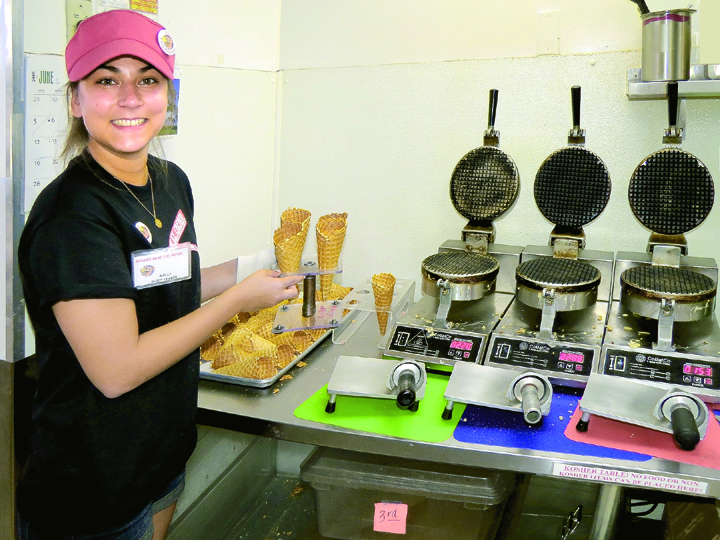 ers in the business. They agreed and the decision was made.
ers in the business. They agreed and the decision was made.
Judy Simon has made ice cream since she was a little girl. The two couples decided to delve into the ice cream business and took two months to renovate the space. They installed new electrical but kept the old floor and some of the old-fashioned signs you see today.
Judy took a class at Utah St. to learn how to modify her recipes for mass consumption. Her mom helped her make the ice cream in the early days making it truly a family affair. Richard Brown came on board in 1988 and after six years of assisting, he took over as head ice cream maker, a positon he holds today.
After making ice cream every day for eight years, Judy now comes in a few times per week to check on the recipes. In fact, all four owners try each batch before it is sold to the public. They also have fun coming up with recipe ideas. A new flavor is introduced every two months. In fact, some recipe ideas came from trips to Italy and France, as well as competing parlors in Colorado.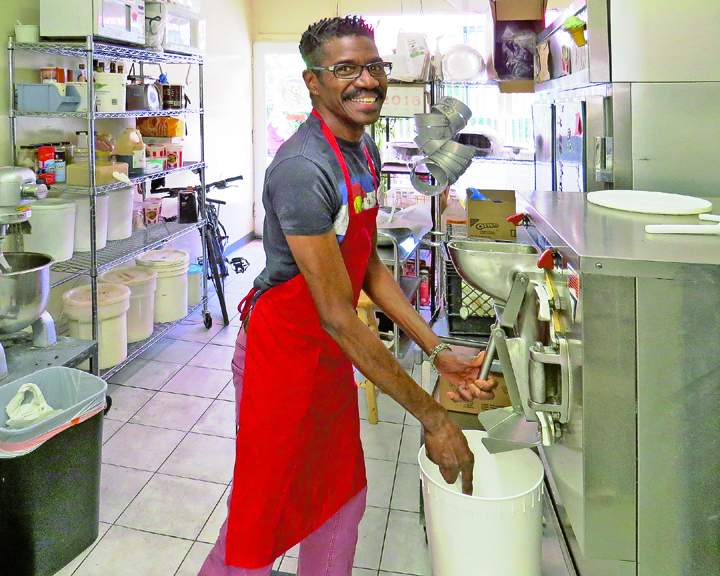
All told, Bonnie Brae Ice Cream has 130 flavors in its arsenal. Flavors rotate daily
but customers can expect 30 flavors of ice cream, two yogurts, one sorbet, and one sherbet on any given day. Sometimes, flavors are retired, but if demand from customers is high enough, they will bring a flavor back.
The most popular flavors which are always in the rotation are Capuccino Crunch, Triple Dip Chocolate, Peppermint, Vanilla, and Chocolate.
The days in the summer are hopping, as they are at many ice cream stores in Denver. It takes a lot to serve that many customers all summer and all year long. “We buy one thousand pounds of chocolate at a time and two thousand pounds of waffle cone mix,” said Simon. The ingredients are specially made for Bonnie Brae Ice Cream as well. “From day one, we decided to sell premium products,” said Simon. “We have continued to do so for 30 years.”
Aside from the massive amounts of ice cream they have produced and sold through the years, Bonnie Brae Ice Cream has employed over 550 people spanning three decades. In fact, some of the employees are second generation. Many have gone on to successful careers. And, there have even been two marriages of employees who met while working at Bonnie Brae.
Perhaps one of the most notable success stories comes from Joe Hencmann, one employee who started working at the store when he was 15. He worked through college and then on weekends until he turned 40 years of age. Last year, he and his wife started their own successful ice cream parlor in Sonoma, near San Francisco.
The ice cream business is competitive just like any other industry but Bonnie Brae has very good relationships with competing parlors, including Denver staples Liks and Little Man. Ken Simon is a fifth generation Coloradan. His great-great-grandfather came from Germany and was one of the early settlers who eventually opened a wholesale liquor distribution business in Pueblo.
Simon’s grandfather opened up a soda fountain distribution business in the early 1900s called Grauman Soda Fountain Company. There is still at least one operational in Lyons, Colorado today, Lyons Soda Fountain. So, Simon knows everyone in town and is almost universally liked.
One thing is for sure, Bonnie Brae Ice Cream will continue to provide what their customers expect and want. They do not plan to suffer the same fate as Dolly Madison did in 1986. They are focused on continuing to deliver premium products to their loyal customer base and evolve with the times.
Bonnie Brae Ice Cream is located at 799 S. University Blvd. in Denver. They are open Sunday to Thursday 11 a.m. to 10:30 p.m. and Friday and Saturday, 11 a.m. to 11 p.m. Visit their website at www.bonniebraeicecream.com.

by Mark Smiley | May 27, 2016 | Travel
by Mark Smiley
 Craft beer fests are popping all over the metro area and for beer enthusiasts, it seems as if there is a different one each weekend.
Craft beer fests are popping all over the metro area and for beer enthusiasts, it seems as if there is a different one each weekend.
A sold-out crowd braved the snowy and cold weather to attend the Bacon and Beer Classic at Sports Authority Field in April. Denver is one of eight cities to host this event around the country. It started in Seattle in 2014 and they are held in sports stadiums in each participating city.
Over 20 local restaurants provided bacon dishes and over 50 regional breweries offered craft beer throughout the concourse. Guests also tried their hand at giant Jenga, struck a pose at the photo booth, battled it out on the bungee run, branded themselves with bacon and beer-inspired tattoos, and some competed in a bacon eating contest.
Much different weather drenched the first ever Craft Beer Fest at the Downtown Aquarium in May. The outdoor event in the sunny and 80-degree day featured 16 breweries including local breweries Joyride and Renegade.
This event has room to grow as the land surrounding the aquarium has room for many more breweries. Some preferred not to attend as Anheuser-Busch InBev, the world’s largest brewer, had several of its breweries on hand which are deemed as anything but craft beer.
Those in attendance, however, enjoyed the beautiful day and many good beers to sample. In addition, the breweries themselves were happy they participated and will be back next year.
One of the larger beer fests this summer will be Summer Brew Fest at Mile High Station on July 22 and 23, 2016. Each day features different breweries in a venue that lends itself to a high quality experience. Visit www.denverbrewfest.com/summer for more information.
On the weekend of August 6, 2016, Keystone Village will play host to the 20th Annual Bluegrass and Beer Festival. It’s the longest running beer festival in the state. Throughout the two days, attendees will be able to pair their favorite brews with free bluegrass music from Jeff Scroggins and Colorado, T Sisters, Lonely Heartstrings Band, Mason Town, Mandolin Orange, Tim O’Brien, Peter Rowan Band, Larry Keel Experience and more.
“This is a special summe r for us at Keystone’s River Run Village,” says Maja Russer, marketing and events director for the Keystone Neighbourhood Company, the organization that coordinates and produces six summer festivals in River Run Village at Keystone Resort. “We’re proud that we were a pioneer when we started the first ‘micro-brew’ festival in Colorado 20 years ago. Since then, we’ve grown and improved the Keystone Bluegrass and Beer Festival and launched new festivals like the Mountain Town Music Festival three years ago and this year’s debut of Keystone’s River Run Village Art Festival.”
r for us at Keystone’s River Run Village,” says Maja Russer, marketing and events director for the Keystone Neighbourhood Company, the organization that coordinates and produces six summer festivals in River Run Village at Keystone Resort. “We’re proud that we were a pioneer when we started the first ‘micro-brew’ festival in Colorado 20 years ago. Since then, we’ve grown and improved the Keystone Bluegrass and Beer Festival and launched new festivals like the Mountain Town Music Festival three years ago and this year’s debut of Keystone’s River Run Village Art Festival.”
For more information on this festival, visit www.keystonefestivals.com/festivals /bluegrass-and-beer.
Also, look for our coverage on the largest beer fest in the country. The Great American Beer Fest comes to the Colorado Convention Center October 6-8, 2016. Tickets for the general public go on sale August 3, 2016. Visit www.greatamericanbeerfestival.com for more information.

 yn has brought a lot of happiness to members, especially the SilverSneakers. Ellyn has been a very committed, dependable, and innovative employee, you can always count on Ellyn.”
yn has brought a lot of happiness to members, especially the SilverSneakers. Ellyn has been a very committed, dependable, and innovative employee, you can always count on Ellyn.” od to join her at the newly formed Glendale YMCA. “I didn’t want to leave Littleton,” said Wood. “I felt comfortable there but Debbie wanted me to come [help open the Glendale location]. She talked me into it.”
od to join her at the newly formed Glendale YMCA. “I didn’t want to leave Littleton,” said Wood. “I felt comfortable there but Debbie wanted me to come [help open the Glendale location]. She talked me into it.” ot of them [seniors] since we were over in the old building,” said Wood. “They are always reminiscing about times in the old building. Because it was just me, I paid a lot of attention to them. They were almost like a family. They loved it.”
ot of them [seniors] since we were over in the old building,” said Wood. “They are always reminiscing about times in the old building. Because it was just me, I paid a lot of attention to them. They were almost like a family. They loved it.” reatly missed by the members and staff.”
reatly missed by the members and staff.”























